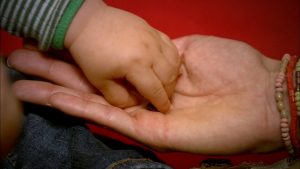From around four months the hand-eye coordination is really starting to develop and it may be that your baby isn’t quite there yet and it’s really important to give them the time and the space to try these things out. So if you are holding something up, they may see the object and then look at their hand and then look at the object again and it might take them quite a while before they’re actually ready to reach out and take it, and if you give up before that time then you’re missing out on something. So it’s really important to be very present and allow things to happen at their own pace.
As parents, because we can grasp these things quite easily, we don’t necessarily wait for the amount of time that a baby would need to do the same task. You can help your baby along by being patient, holding something out for them and keep it there for a long time so they can practise reaching towards it and eventually holding on.
Babies should not show a preference for one hand over the other until about 18 months of age so if your baby always favours one hand and arm it’s worth getting him checked out by your doctor in case he has an injury or a difficulty in using the non-favoured side.

At first, your baby will reach for an object and grasp it with a whole palm grasp. This makes manipulating the object they are holding very challenging. Babies grasp food and crayons in their fist and use their whole arm to move it around. However, in human beings (and human beings alone with their unique opposible thumbs) finer coordination takes over. One of the physical things that sets us apart from nearly every other animal is our opposable thumbs and forefingers. By around 12 months, you can help your baby to practice picking up objects with fingers and thumb rather than with his first. Try safe small treats like raisins that won’t roll away and let him have plenty of practice as it’s a whole new system of physical development.